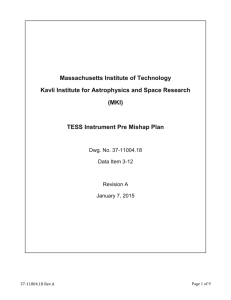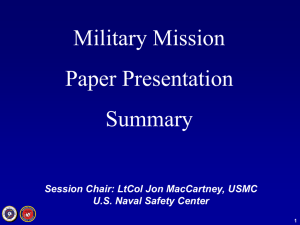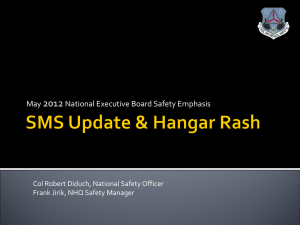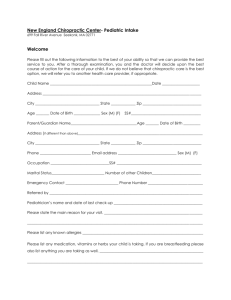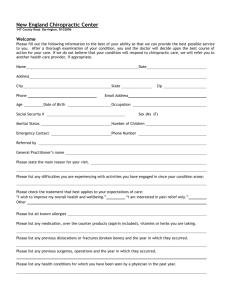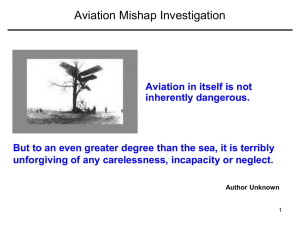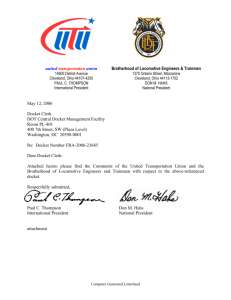Risk Assessment Matrix
advertisement
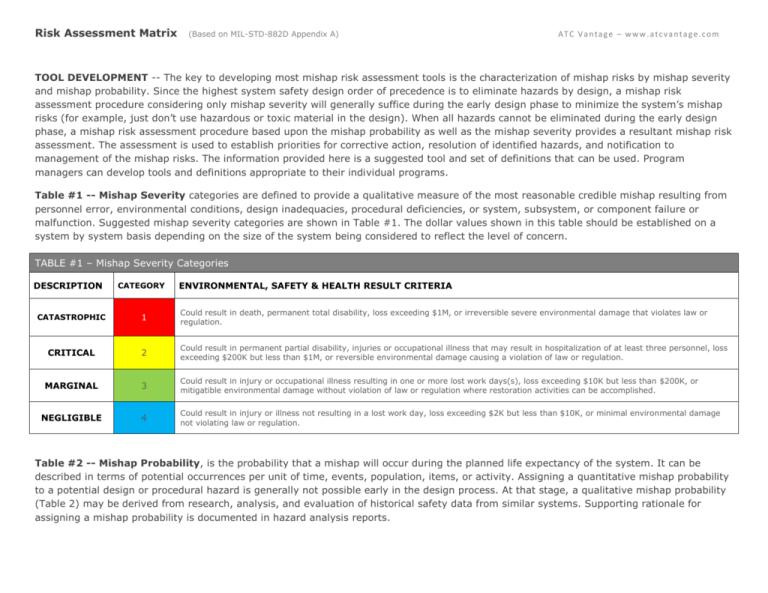
Risk Assessment Matrix (Based on MIL-STD-882D Appendix A) AT C V a n t a g e – w w w . a t c v a n t a g e . c o m TOOL DEVELOPMENT -- The key to developing most mishap risk assessment tools is the characterization of mishap risks by mishap severity and mishap probability. Since the highest system safety design order of precedence is to eliminate hazards by design, a mishap risk assessment procedure considering only mishap severity will generally suffice during the early design phase to minimize the system’s mishap risks (for example, just don’t use hazardous or toxic material in the design). When all hazards cannot be eliminated during the early design phase, a mishap risk assessment procedure based upon the mishap probability as well as the mishap severity provides a resultant mishap risk assessment. The assessment is used to establish priorities for corrective action, resolution of identified hazards, and notification to management of the mishap risks. The information provided here is a suggested tool and set of definitions that can be used. Program managers can develop tools and definitions appropriate to their individual programs. Table #1 -- Mishap Severity categories are defined to provide a qualitative measure of the most reasonable credible mishap resulting from personnel error, environmental conditions, design inadequacies, procedural deficiencies, or system, subsystem, or component failure or malfunction. Suggested mishap severity categories are shown in Table #1. The dollar values shown in this table should be established on a system by system basis depending on the size of the system being considered to reflect the level of concern. TABLE #1 – Mishap Severity Categories DESCRIPTION CATEGORY ENVIRONMENTAL, SAFETY & HEALTH RESULT CRITERIA CATASTROPHIC 1 Could result in death, permanent total disability, loss exceeding $1M, or irreversible severe environmental damage that violates law or regulation. CRITICAL 2 Could result in permanent partial disability, injuries or occupational illness that may result in hospitalization of at least three personnel, loss exceeding $200K but less than $1M, or reversible environmental damage causing a violation of law or regulation. MARGINAL 3 Could result in injury or occupational illness resulting in one or more lost work days(s), loss exceeding $10K but less than $200K, or mitigatible environmental damage without violation of law or regulation where restoration activities can be accomplished. NEGLIGIBLE 4 Could result in injury or illness not resulting in a lost work day, loss exceeding $2K but less than $10K, or minimal environmental damage not violating law or regulation. Table #2 -- Mishap Probability, is the probability that a mishap will occur during the planned life expectancy of the system. It can be described in terms of potential occurrences per unit of time, events, population, items, or activity. Assigning a quantitative mishap probability to a potential design or procedural hazard is generally not possible early in the design process. At that stage, a qualitative mishap probability (Table 2) may be derived from research, analysis, and evaluation of historical safety data from similar systems. Supporting rationale for assigning a mishap probability is documented in hazard analysis reports. Risk Assessment Matrix (Based on MIL-STD-882D Appendix A) AT C V a n t a g e – w w w . a t c v a n t a g e . c o m TABLE #2 – Mishap Probability Levels DESCRIPTION LEVEL SPECIFIC INDIVIDUAL ITEM OCCURRENCE FREQUENT A Likely to occur often in the life of an item, with a probability of occurrence greater than 10 -1 in that life Continuously experienced PROBABLE B Will occur several times in the life of an item, with a probability of occurrence less than 10-1 but greater than 10-2 in that life. Will occur frequently OCCASIONAL C Likely to occur sometime in the life of an item, with a probability of occurrence less than 10-2 but greater than 10-3 in that life. Will occur several times REMOTE D Unlikely but possible to occur in the life of an item, with a probability of occurrence less than 10-3 but greater than 10-6 in that life. Unlikely, but can reasonably be expected to occur IMPROBABLE E So unlikely, it can be assumed occurrence may not be experienced, with a probability of occurrence less than 10-6 in that life. Unlikely to occur, but possible TABLE #3 – Mishap Risk Classification SEVERITY→ PROBABILITY ↓ 1 CATASTROPHIC 2 CRITICAL 3 MARGINAL 4 NEGLIGIBLE A - Frequent 1 3 7 13 B - Probable 2 5 9 16 C - Occasional 4 6 11 18 D - Remote 8 10 14 19 12 15 17 20 E - Improbable TABLE #4 – Mishap Risk Assessment Values Mishap Risk Assessment Value Mishap Risk Category Mishap Risk Acceptance Level 1-5 High Not acceptable – operation stopped 6-9 Serious CEO 10-17 Medium Chief Pilot 18-20 Low As directed Table #3 -- Mishap Risk Classification by mishap severity and mishap probability can be performed by using a mishap risk assessment matrix. This assessment allows one to assign a mishap risk assessment value to a hazard based on its mishap severity and its mishap probability. This value is then often used to rank different hazards as to their associated mishap risks. An example of a mishap risk assessment matrix is shown at Table 3. Table #4 – Mishap Risk Categories are often used in grouping individual hazards into mishap risk categories. Mishap risk categories are used to generate specific action such as mandatory reporting of certain hazards to management for action or formal acceptance of the associated mishap risk. Table 4 includes an example listing of mishap risk categories and the associated assessment values. In the example, the system management has determined that mishap risk assessment values 1 through 5 constitute “High” risk while values 6 through 9 constitute “Serious” risk.
